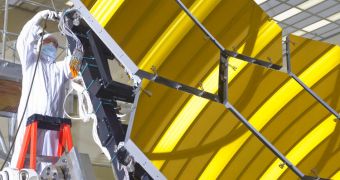The NASA James Webb Space Telescope (JWST) development program has reached a new milestone recently, when both the primary and secondary mirrors that will go on the massive observatory successfully completed cryogenic testing.
This phase is absolutely essential for the good functioning of the JWST, which will be the largest and most complex telescope ever to be deployed in space. Its primary eyes, for example, are made up of 18 hexagonal mirror segments, which are polished and fitted together with unprecedented accuracy.
In fact, manufacturing and testing these mirrors led to numerous innovations in the field of producing mirrors. The manufacturing technologies available years ago, when work on the JWST began, were insufficient for the level of precision required of the telescope, so new ones had to be invented.
This is part of the reason why the observatory project has gone so much over budget. The machine was not put together using the same technologies that were used to assemble Hubble, for example. In all, the telescope has 21 mirrors, of which 18 work as a single, 6.5-meter-aperture lens.
Each of the segments has been cryogenically proven to be able to withstand temperatures of 40 degrees Kelvin (-387ºFahrenheit or -233ºCelsius). Keeping temperatures on and around the telescope low is essential for being able to observe the faint Universe.
“The mirror completion means we can build a large, deployable telescope for space. We have proven real hardware will perform to the requirements of the mission,” Northrop Grumman Aerospace Systems vice president and JWST program manager Scott Willoughby reports.
With the successful completion of the cryogenic testing, experts at NASA say, the most challenging and technologically-difficult part of the entire project has been completed. That is not to say that the remaining tasks are easy, but they have been done before, and engineers have the necessary experience.
“Mirrors need to be cold so their own heat does not drown out the very faint infrared images. With the completion of all mirror cryogenic testing, the toughest challenge since the beginning of the program is now completely behind us,” Lee Feinberg explains.
The expert holds an appointment as the Optical Telescope Element manager for the JWST, at the NASA Goddard Space Flight Center (GSFC), in Greenbelt, Maryland. The tests were conducted inside the X-ray and Cryogenic Facility (XRCF), at the Marshall Space Flight Center in Huntsville, Alabama.
“Achieving the best performance requires conditioning and testing the mirrors in the XRCF at temperatures just as cold as will be encountered in space. This testing ensures the mirrors will focus crisply in space, which will allow us to see new wonders in our Universe,” XRCF JWST program manager Helen Cole explains.

 14 DAY TRIAL //
14 DAY TRIAL //